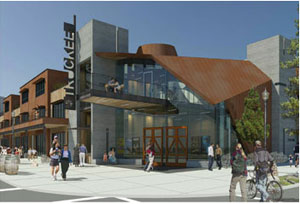ULI advisory panel helped keep Tahoe blue
URBAN LAND INSTITUTE MAGAZINE
by by Valerie Fahey
February 29, 2012
Lake Tahoe, the largest, highest-elevation alpine lake in North America, is one of the most treasured natural wonders in the United States. But its pristine natural beauty and abundant recreational opportunities have also put pressure on the area by bringing in growing numbers of vacationers and year-round residents. With its jewel-like fresh-water lake cradled by snow-peaked mountains even in the summer months, Lake Tahoe is one of the top international attractions in California.
In the early 1980s, regional officials became increasingly concerned about the prospects for the area’s long-term sustainability—both environmental and economic—and brought in a ULI Advisory Services panel to provide guidance on several key fronts. The ensuing report and implementation of many of the panel’s recommendations have been seen as a case study for how to improve regional planning.
Once a sleepy resort area, the Tahoe basin boomed after the 1960 Winter Olympics. The games introduced millions of viewers to the area’s natural beauty, and Olympics-related infrastructure upgrades, including major freeway access, facilitated the rapid increase in the number of permanent residents from 10,000 to more than 50,000 in two decades. The summer population has swelled from 10,000 before the Olympics to nearly ten times that amount today, according to the U.S. Geological Survey. However, rising real estate prices helped slow population growth, and the permanent year-round population today is estimated at about 35,000.
In 1980, Congress set air and water quality thresholds to drive the planning efforts of the Tahoe Regional Planning Agency (TRPA), an entity formed by Nevada and California. While traffic and transportation were obvious pressure points, the interrelated problems of growth, land use, and strategic planning were exacerbating the underlying crisis.
Responding to 20 years of largely unfettered growth, the Tahoe Basin Association of Governments (TBAG) in 1985 commissioned the ULI advisory panel to address the growing problems, marked by poor land use planning, overlapping jurisdictional efforts, regulatory uncertainties affecting land rights, and other factors contributing to a declining regional economy. At the same time, researchers were beginning to quantify degradation and longer-term threats to Lake Tahoe’s water quality, which were exacerbated by poor development practices. TBAG concluded that communities surrounding the 192-square-mile (149-sq-km) lake had “an abundance of planning efforts and data, . . . but the need now is to achieve protection of Lake Tahoe without bankrupting the private and public sectors.”
The Advisory Services panel brought together a nine-member group of ULI members from diverse backgrounds to address Lake Tahoe’s problems, which were seen as far reaching and systemic. Panelists included John B. Turner, Jr., president, Friendswood Development in Houston; H. James Brown, Massachusetts Institute of Technology–Harvard Joint Center for Housing Studies; Gregory L. Cory, vice president, Economic Research Associates in San Francisco; John M. DeGrove, Florida Department of Community Affairs; William R. Eager, TDA Inc. in Seattle; Robert M. O’Donnell, HOH Associates in Denver; Frank Schnidman, Lincoln Institute of Land Policy, Cambridge, Massachusetts; George Sternlieb, Rutgers University Center for Urban Policy; and Joachim Tourbier, University of Delaware Water Resources Center.
Among the advisory panel’s key recommendations that were implemented in part or in full were the following:
TRPA was endorsed as the best-positioned and best-equipped vehicle for implementing regional change, rather than creation of a new and potentially political two-state superagency, as had been proposed.
TRPA and relevant authorities were urged to create a simpler, more reliable system for development zoning of undeveloped land, including weighting of environmentally sensitive areas. The panel suggested that reviews and revisions be undertaken periodically to both protect the environment and avoid legal challenges.
Implementation of a regionwide transportation system using lower-cost buses underwritten by a permanent funding source was encouraged. An expensive rail system had been proposed.
TBAG and others were urged to adopt a new economic development approach for the region. The panel recommended that rather than rely on ever-expanding commercial development, TBAG and others should upgrade the caliber and character of existing recreational, residential, and commercial components, thus reducing pressure on the environment while engendering prosperity through revenue from higher-spending visitors.
In order to attract a strong and diverse resident population, provision of a balance of affordable housing was encouraged as a counterpart to the strategy of upgrading the Tahoe experience; provision of close-in housing for workers was also encouraged.
Expansion of user fees, transient-occupancy taxes, and other funding strategies were encouraged to finance the region’s improvements, with the panel recognizing that an education/information effort would be needed to convince residents of the cost/benefit tradeoffs involving their higher taxes and higher standard of living.
Truckee Railyard, a major mixed-use community scheduled to start construction this year, is one example of the lasting impact of the Advisory Services panel recommendations. The 900,000-square-foot (84,000-sq-m) community, which provides housing over commercial space in Truckee’s century-old downtown, embodies principles of smart growth and close-in development, as well as the panel’s recommendations for increasing density in existing areas rather than developing pristine land. The project, though proposed nearly a decade ago, only received unanimous town council and Planning Commission approval in 2009, according to project sponsor Holliday Development.
While the Lake Tahoe region continues to face the delicate balancing act of economic and environmental prosperity, thanks in part to the ULI advisory panel, visitors can still enjoy the clear waters and thriving communities coexisting there today.
http://urbanlandstaging.uli.org/Articles/2012/Jan/FaheyTahoe



